§1. GENEALOGICAL DATA
This article is about João Maria António da Silva, a Macanese botanist, born in Macao on the 7th of September 1834. His parents were João Maria da Silva and Alexandrina Maria Vieira, married at Sé (Cathedral) of Macao, on the 5th of October 1833. His paternal grandparents were João da Silva and Maria Esperança Xavier and his maternal grandparents were Joaquim Vieira Ribeiro and Ana António Barros.
Joaquim Xavier Ribeiro's parents were Inácio Vieira Ribeiro — a Chinese — and Caetana Simões, his paternal grandparents being Tomás Vieira Ribeiro and Clara de Lacerda, and his maternal grandparents being Domingo Simões and Caleta de Abreu — a Chinese, servant of Nicolau Fiume.
There is a street in Macao with Tomás Vieira Roberto's name called Rua Tomás Vieira. It links the Rua Coelho do Amaral (Coelho do Amaral Street) to Estrada do Cemitério (Cemitery Road).
João Maria António da Silva married and had a number of children. One of his daughters was named Maria Alexandrina.
[...]
§2. A MACANESE BOTANIST
José Pedro Braga, in his opusculum entitled The Portuguese Pioneers of Hong Kong1 writes that "The earliest Crown lessees of Kowloon were Messrs. J. M. A. da Silva, Mathias Azevedo, A. Brandão, A. M. Alves, A. Chagas, F. X. Ribeiro and Candido A. Ozorio."2
José Maria [Jack Braga] writes on the Preface of his father's opuscule: "When the wonders of wireless telegraphy first became known through the early invention of Marconi, the late J. M. A. da Silva gave the first demonstration of wireless telegraphy in the big hall of the old Club Lusitano building in Shelley Street. Mr. da Silva is the author of a book in Portuguese that should be of great interest to botanists and naturalists could a translation of the work be made into English so that the worth of the work may become more widely known. The edition of the book is a small one; it bears the title Noções de Botanica Aplicada."3 To this we must add that a reprint of this work in Portuguese has been long due.
In 1933, A. C. de Sá Nogueira published the Catálogo descritivo de 380 espécies batânicas da Colónia de Macau (Descriptive Catalogue of 380 botanical species which exist in the Colony of Macao) in which bibliographic references are listed the Repositório de noções de Botânica [...] (Repository of some notions on Botany [...]) by J. M. A. da Silva.
Neither Jack Braga nor Sá Nogueira fully quoted the complete title and the author's full name of this three-hundred-and-thirty-two page book, which are: Repositorio de noções de botanica aplicada. e productos vegetáes mais conhecidos e usados na China, tanto na economia domestica como na therapeutica e nas artes, extrahidas e compiladas de diversas obras por João Maria Antonio da Silva, Cavalleiro da ordem militar de Nosso Senhor Jesus Cristo. (Repository of some notions on applied Botany and on the better known vegetable products used in China, both in domestic households as in therapies as well as in the arts, extracted and compiled from a variety of written sources by João Maria António da Silva, Knight of the Military Order of Our Lord Jesus Christ.), Hong Kong, Typographia de Noronha & Co, 1904.
The copy of this book which we own has the following handwritten dedication: "A minha querida filha Maria Alexandrina, para preservar como memória d' um pai muito extremoso. 0 Auctor." ("To my darling daughter Maria Alexandrina, so that she may cherish it in memory of a loving father. The Author." [Signature]
His daughter kept it throughout her life. After her death the book belonged to her heirs and it was from them that we acquired it. We cherish it as the work of one of the greatest Macanese botanists and a pioneer of Hong Kong.
In the Razão deste livro (Reason for this book) of his book João Maria António da Silva stated that the work was meant to be a companion guide to his compatriots "[...] who, for centuries already have been making use of numerous plants from China and from the regiões occidentais (occidental regions), their leaves, roots and fruits, and their by products, being used as medicine as well as foodstuf. [...] because it is certain that some medicaments which in the Orient are therapeutical in fighting certain diseases, are not so efficacious in other climatically different regions. It is not rare to observe Oriental natives illnesses' improved by treatments with leaves, roots and fruits which are either unknown in Europe or not medicinally prescribed — as equal botanical therapies may produce exceptional and specific side effects according to climatic differentiations.
I feel that the value of this book lies exclusively in the novel presentation of its material, and if further values may be found in it they lie beyond the intentions of my endeavours."4
The author ends the book's Preface thanking Manuel Fernandes de Carvalho for the text revisions and corrections, and João Maria (his son) for its final proofreading.
One of the most interesting aspects of the book is the way in which each plant is individually presented in Portuguese, Chinese and English together with its Latin scientific name, followed by a text expliciting its history and medicinal qualities.
Follow facsimilae of some of the book's pages together alongside with translations of its text.
Bambu, Bambueira. — Arundo bambusa. Bambusa arundinacea (Graminaceœ). BAMBOO.
竹 Choe [竹 zhu].
Because it is the most versatile plant for the Chinese who make use of it in all sorts of ways, it was given the name of "The Friend of China". They use bamboo to build houses, make furniture and appliances, prepare medicaments, and even as a food. Because the plant has a long life span, the bamboo is for the Chinese an emblematic represention of "longevity". There are about sixty known varieties of this plant. The young shoots of one or two varieties are edible. In order to make the shoots edible as soon as they sprout from the earth they are covered by a vase which prevents its stem from getting taller and becoming thick instead — some reaching 4 to 5 inches in diameter. They are then cut and sold as a vegetable which is named 'Choc-son' [罣囹zhusun]. The Chinese credit it with refreshing/soothing and galactogogue-lactigenic propreties and recommend it to breast feeding women. The bamboo plant's young tender leaves and its root are used as medicine.
BANANAS
According to Dr. Brotero some ancient authors and the Portuguese from the Orient gave the name of 'figos' (figs) the fruits which are commonly known as 'bananas'. In Macao these fruits are still known these days as 'figos' and their plant 'figueira' (fig tree).
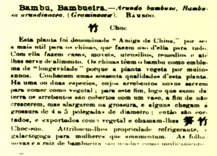
Dr. Garcia da Orta in his book on Coloquios (Colloques) says: — "In the languages from the Kanari, Deccan, Guzarat, and Bengal 'figos' are called 'quelli', the Malabars call it 'palam', and the Malays 'piçam'; the Arabs call them 'musa' or 'amusa' and in Guinea they are known as 'bananas': because in all these lands they exist and that is why I can tell you how they are named in those different languages." Orta succintly gives an African origin to the name "banana", which is presently the most common of all amongst the Oriental Christians and the Musulmans. The banana tree of the earthly Paradise was traditionally known as the tree whose leaves Adam and Eve used to cover themselves with after commiting the original sin.. "Consuerunt folia ficus, et fecerunt sibi perizomata."
Banana, Bananeira ordinaria, (Figo villão). — Musa paradisiaca, (Musaceœ). PLANTAIN.
蕉大 Tai-chiu. [大蕉 dajiao].
Since the most remote days of Antiquity the plantain is grown in all the tropical countries. Its fruits feed millions of people; the amount of fruits to be found on each tree being proportionally higher in relation to the space occupied by the plant than those of any other plant. For instance, a patch of land which may yield 33 pounds of wheat, or 99 pounds of potatoes, will produce 4,400 pounds of bananas. The field bananas are coarser and larger than the 'bananas da horta' (bananas), their flavour being less delicate and slightly acidic. Drinking a glass of water after eating one or two of these bananas will produce a mildly laxative effect. Banana fritters sprinkled with sugar and cinnamon make a good dessert. The fermented juice of their stalks is common in India. Their dry leaves turned into tobacco beadies' wrappers are pleaseantly aromatic and equally common in India; while the green leaves are used in retail shops to wrap fertilizers and other produces. In Macao, the bunch of the topmost inner core which contains very small fruits unable to develop is called "'janton' (a Malay word which means 'heart' because of its colour and shape). It is a vegetable ingredient of curry.
Banana da horta, (Figo de horta). — Musa sapientum. BANANA.
蕉甘 Cam-chiu. [甘蕉 ganjiao].
香山 San-heong. [ 山香 shanxiang].
This delicious fruit is the most 'innocent' of all its species, being recommended to those suffering from dyspespsia and to all those convalescing from any sort of afflictions. According to Chinese doctors it is refreshing, pectoral and an alterative and an ideal remedy against scurvy. Because of its high value in nutrients and easy digestion, banana flour is prescribed as a diet for all those suffering from dyspepsia.
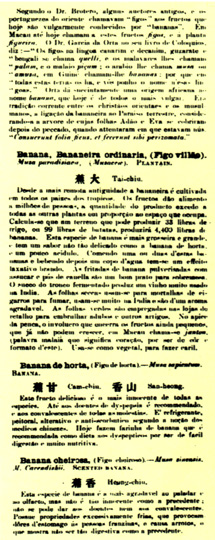
Banana cheirosa, (Figo cheiroso). — Musa sinensis. M. Cavendishii. SCENTED BANANA.
蕉香 Heong-chiu. [香蕉 xiangjiao].
From all its species this is the tastiest and the most odoriferous, although is not as 'innocent' as the precedent. It is not recommended to those ill or convalescing. Because of excessive 'cold' in frail persons its properties provoke stomach aches and burps, thus confirming it as not being as digestible as the precedent.
Banana aveludada, (Figo veludo). — Musa coccinea. [lit: VELVETY BANANA].
Banana agreste. — Musa paradisiaca agrestis. [lit: WILD BANANA].
This banana species is native to Singapore and all the Straights [sic]. The Malays call it 'Pissang tamtó'. Its the largest of all the bananas: usually 12 to 15 inches long and 2 to 3 inches in diameter. Each branch only has two fruits. Because it does not ripen it remains hard and with a bad taste not be eaten raw. It is usually baked or boiled and eaten with meat and potatoes. Its flavour is similar to sweet potato.
Banian. — Ficus Indica. (Moraccœ). BANIAN TREE.
It is a frondescent tree common in all India similar to the 'Pagoda' tree [banyan] of China. From its branches grow roots which penetrate the ground and from which rise other branches of various thicknesses which support the bulk of the tree with its canopy which may cover a vast surface. There is another species which can only be distinguished from this one by its leaves. It is called 'Ficus religiosa' because it is considered religious by the Hindus.
Ninho de passaro. BIRD'S NEST.
Ien-uo [窩燕 yanwo].
Nests made by a species of maritime swallows which frequent in Java, Borneo, Ceylon and other Islands of the Indian Archipelago. It is thought that these birds' nests are made of an extremely gelatinous marine plant called "Gelidium" or of another quality which grow on rocks. These small birds make their nests in the cavities of rocks in the caverns which give good shelter from the rain and sun. In order to remove the down which is glued to the nests the Chinese soften them by soaking them in water, and highly value those which are white and clean. This expensive product which is a delicacy for the rich and a medicine for the sick is known to have tonic and invigorating qualities second best to "Gensam" [Ginseng]. The more the products are rare, extraordinary and expensive, the more the Chinese love to phantasise about them. The fantastical ideas the Chinese literati and doctors spread about these products matches the faith the people have in their healing qualities.
Pateca, or Melancia. Cucumis citrulus pasteca. (Cacurbitaceœ). RED FLASHED WATER MELON.
瓜西 Sai-qua. [西瓜 xigua].
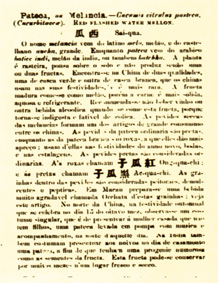
The name "melancia" comes from the Latin'mela', melon, and the Castilian 'ancha', big. 'Pateca' derives from the Arabic 'batice indi' (Indian melon), or from 'batchka'. This is a creeping plant which grows at ground's level, only bearing or or two fruits. In China, there are two kinds, one with green skin and another with a white skin which is rarer and very popular with the Chinese in their festivities. When ripe the fruit is eaten like melon, although their pulp is firmer, and more acquous and refreshing. When eating this fruit it is not advisable to have wine or alcoholic drinks as it can become indigestible and give colic. The Chinese consume great quantities of dry watermelon pips. The pips of the most abundant species of watermelon are black. Those of the white variety are violet and are the most appreciated by the Chinese who consume them during New Year festivities, and weddings. They are also served at inns. The black pips are the most ordinary. The violet coloured ones are called 'Ong-qua-chi' [紅瓜子 hongguazi] and the black ones Ac-qua-chi' [黑瓜子 heiguazi]. The kernels of the pips are considered good for their pectoral, demulcent and peptic properties. In Macao, with these pips is made a pleasant drink called 'Orchata'. In the North of China, during the Autumn festivity of the 15th of September, there is the singular tradition of offering to married women without children, a water melon, taken on the night of the festive day to the woman's residence in great pomp accompanied by a musical fanfare.
In India it is traditional to offer on the marriage day a water melon to the newly weds wishing them a prolific fertility as abundant as the pips of the fruit. This fruit can be kept for many months in a cool and dry place.
Tabaco, or Erva santa. Nicotiana tabacum. (Solanaceœ). TOBBACCO.
树烟 In-si. [树烟 yanshu].
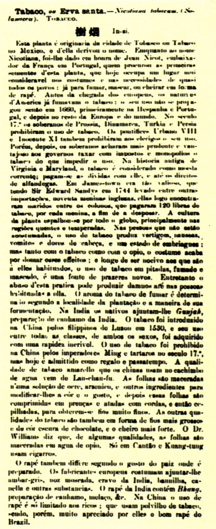
This plant is a native from the town of Tobasco or Tabaco, in Mexico, from where derived its name. The name 'nicotin' was given in honour of Jean Nicot an ambassador of France in Portugal who sought the seeds of this plant. Nowadays this plant occupies a proeminent place in the habits and needs of almost all the people who smoke it, chew it, or inhale it as snuff. The Americans already smoked tobacco before the arrival of the Europeans. Only after 1660 it became popular, first in Spain and in Portugal, then in the rest of Europe and afterwards worldwide. In the seventeenth century the rulers of Prussia, Denmark, Turkey and Persia forbade the consumption of tobacco. The popes Urban VIII and Innocent XI equally forbade its use by members of the clergy.
Later rulers found it more prudent and profitable their governments not to forbid tobacco, but to control it through monopolies and the levying of taxes. In the early history of Virginia and Maryland tobacco was the normal exchange currency good for paying debts and even custom duties. In 1744, it was so [p.276] valuable in Jamestown that Sir Edward Sandys having imported ninety English girls to trade them as brides amongst the colonists found no difficulty to obtain as much as 120 pounds weight of tobacco for each. The cultivation of the plant spread throughout the whole world, mainly in the hot and warm regions. Those who are not used to tobacco get vertigo, nausea, vomiting, headaches and a general state of drunkeness from it. Such as with opium, the habit of tobacco can overcome such side effects, and far from being pernicious to those who use it, the consumption of snuffed smoked or chewed tobacco is a renewed source of pleasure. But the abuse of its consumption may be detrimental even to people addicted to it. The aroma of smoking tobacco may be ascertained according to the plantation where it comes from and the way it is fermented. In India, the local people mix it with 'Gunjab' which is a mixture derived from Indian hempo. In 1530, the Filipinos from Luzon introduced tobacco in China, its use amongst all classes and by both sexes rapidly spreading. During the seventeenth century the use of tobacco was forbidden in China by the Ming and Tartar [Qing] Emperors, although these days it is allowed as a pleasure and pastime. The yellow tobacco quality that the Chinese use in their water-pipes comes from Lan-chau-fu. The leaves as macerated in a solution of ochre, arsenic and other ingredients which change their colour and taste. The leaves are then compacted on presses and tied with ropes, afterwards being shredded in order to finally obtain very thin strips. Other tobacco qualities are also reduced to strips, although wider of a dark chocolate colour and stronger smelling. Dr. Williams says that certain qualities are macerated in an opium water solution. Only in Canton and in Kuang-tung are used cigarettes.
Tobacco snuff also differs according to the taste of the country where it is prepared. European merchants usually mix it with ambergris, nutmeg, Indian cloves, vanilla, cinammon, and other products. In India its added to the tobacco sniff "Bhang", a mixture of hemp, molasses, etc. In China snuff made with ground tobacco is just for the rich. The high quality snuff from Brazil is also much appreciated.
Tabaco de Havana. — Nicotiana repanda. HAVANA TOBACCO.
Tabaco de Shiraz. — Nicotiana persica. PERSIAN TOBACCO.
Tabaco da China, and das Filipinas. — Nicotiana fructicosa. Nicotiana rustica. CHINESE TOBACCO.
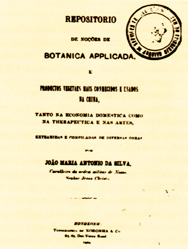
NOTES
1 BRAGA, José Pedro, The Portuguese Pioneers of Hong Kong, Macau, Instituto Cultural de Macau, 1897[reprint of: Offprint of "Macao Review", 1930].
2 Ibidem., p.26.
3 Ibidem., pp. 20-21.
4 SILVA, João Maria António da, Repositorio de noções de botanica aplicada. e productos vegetáes mais conhecidos e usados na China, tanto na economia domestica como na therapeutica e nas artes, extrahidas e compiladas de diversas obras por João Maria Antonio da Silva, Cavalleiro da ordem militar de Nosso Senhor Jesus Cristo., Hongkong, Typographia de Noronha & Co, 1904., pp. v-vi.
* Historian and researcher of the Portuguese Expansion and the Christian Church in the Orient. Author of numerous articles and publications on related topics. Member of the Portuguese Academy of History, the International Association of Historians on Asia and other Institutions.
start p. 100
end p.